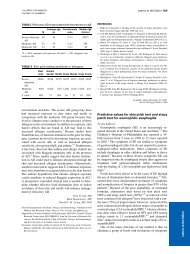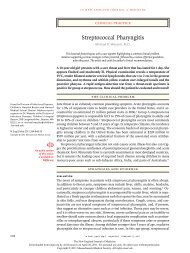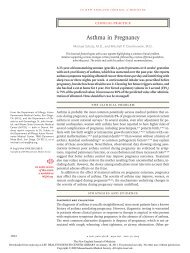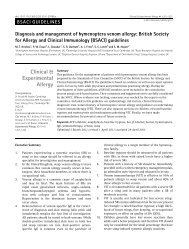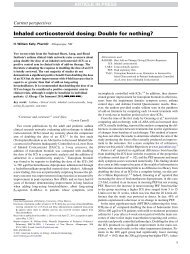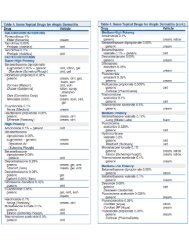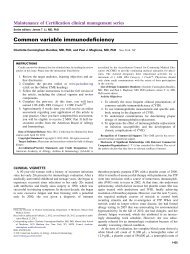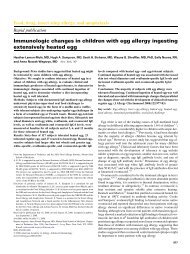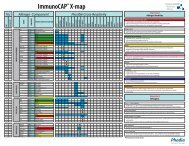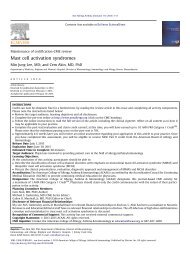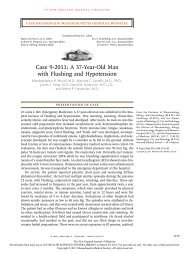Role of specific IgE and skin-prick testing in predicting food ... - AInotes
Role of specific IgE and skin-prick testing in predicting food ... - AInotes
Role of specific IgE and skin-prick testing in predicting food ... - AInotes
Create successful ePaper yourself
Turn your PDF publications into a flip-book with our unique Google optimized e-Paper software.
<strong>Role</strong> <strong>of</strong> <strong>specific</strong> <strong>IgE</strong> <strong>and</strong> <strong>sk<strong>in</strong></strong>-<strong>prick</strong> <strong>test<strong>in</strong>g</strong> <strong>in</strong> predict<strong>in</strong>g<strong>food</strong> challenge results to baked eggCather<strong>in</strong>e F. Cortot, M.D., 1,2 William J. Sheehan, M.D., 1,2 Perdita Permaul, M.D., 2,3James L. Friedl<strong>and</strong>er, M.D., 1,2 Sach<strong>in</strong> N. Baxi, M.D., 1,2 Jonathan M. Gaff<strong>in</strong>, M.D., M.S., 2,4Anahita F. Dioun, M.D., 1,2 Ela<strong>in</strong>e B. H<strong>of</strong>fman, Ph.D., 5 Lynda C. Schneider, M.D., 1,2<strong>and</strong> W<strong>and</strong>a Phipatanakul, M.D., M.S. 1,2ABSTRACTPrevious studies suggest that children with egg allergy may be able to tolerate baked egg. Reliable predictors <strong>of</strong> a successfulbaked egg challenge are not well established. We exam<strong>in</strong>ed egg white–<strong>specific</strong> <strong>IgE</strong> levels, <strong>sk<strong>in</strong></strong>-<strong>prick</strong> test (SPT) results, <strong>and</strong> ageas predictors <strong>of</strong> baked egg oral <strong>food</strong> challenge (OFC) outcomes. We conducted a retrospective chart review <strong>of</strong> children, aged 2–18years, receiv<strong>in</strong>g an egg white–<strong>specific</strong> <strong>IgE</strong> level, SPT, <strong>and</strong> OFC to baked egg from 2008 to 2010. Fifty-two oral baked eggchallenges were conducted. Of the 52 challenges, 83% (n 43) passed <strong>and</strong> 17% (n 9) failed, <strong>in</strong>clud<strong>in</strong>g 2 hav<strong>in</strong>g anaphylaxis.Median SPT wheal size was 12 mm (range, 0–35 mm) for passed challenges <strong>and</strong> 17 mm (range, 10–30 mm) for failed challenges(p 0.091). The negative predictive value for pass<strong>in</strong>g the OFC was 100% (9 <strong>of</strong> 9) if SPT wheal size was 10 mm. Medianegg white–<strong>specific</strong> <strong>IgE</strong> was 2.02 kU/L (range, 0.35–13.00 kU/L) for passed challenges <strong>and</strong> 1.52 kU/L (range, 0.51–6.10 kU/L)for failed challenges (p 0.660). Receiver operat<strong>in</strong>g characteristic (ROC) curve analysis for SPT revealed an area under thecurve (AUC) <strong>of</strong> 0.64. ROC curve analysis for egg white–<strong>specific</strong> <strong>IgE</strong> revealed an AUC <strong>of</strong> 0.63. There was no significantdifference <strong>in</strong> age between patients who failed <strong>and</strong> those who passed (median 8.8 years versus 7.0 years; p 0.721). Basedon our sample, SPT, egg white–<strong>specific</strong> <strong>IgE</strong> <strong>and</strong> age are not good predictors <strong>of</strong> pass<strong>in</strong>g a baked egg challenge. However, therewas a trend for more predictability with SPT wheal size.Egg allergy is one <strong>of</strong> the most common <strong>food</strong> allergies<strong>in</strong> <strong>in</strong>fants <strong>and</strong> young children with an estimatedprevalence between 0.5 <strong>and</strong> 2.5%. 1 A st<strong>and</strong>ard diagnosticapproach <strong>in</strong>cludes a thorough cl<strong>in</strong>ical history <strong>in</strong>comb<strong>in</strong>ation with <strong>sk<strong>in</strong></strong>-<strong>prick</strong> <strong>test<strong>in</strong>g</strong> (SPT) <strong>and</strong> <strong>food</strong><strong>specific</strong><strong>IgE</strong> values to egg white. Treatment recommendationshave <strong>in</strong>cluded strict avoidance <strong>of</strong> egg, <strong>in</strong>clud<strong>in</strong>gbaked products conta<strong>in</strong><strong>in</strong>g egg, with the theorythat even m<strong>in</strong>ute <strong>in</strong>gestions could provoke symptomsor even delay natural resolution <strong>of</strong> the egg allergy.Another theory suggests that the early <strong>in</strong>troduction <strong>of</strong><strong>food</strong>s may <strong>in</strong>duce tolerance. It has recently been reportedthat many children with egg allergy may actuallybe able to tolerate heated or baked egg. 2–5 Themechanism for heated egg tolerance is related to egg(Allergy Asthma Proc 33:275–281, 2012; doi: 10.2500/aap.2012.33.3544)prote<strong>in</strong>s be<strong>in</strong>g denatured dur<strong>in</strong>g the heat<strong>in</strong>g process,thereby, dim<strong>in</strong>ish<strong>in</strong>g the allergenicity. Predictors <strong>of</strong>tolerance to baked egg may improve quality <strong>of</strong> life <strong>in</strong><strong>food</strong>-allergic children because baked egg is found <strong>in</strong> somany <strong>food</strong>s.Retrospective <strong>and</strong> prospective studies have now reportedthat 55–93% <strong>of</strong> children with egg allergy areable to tolerate baked egg without reaction. 2–5 Furthermore,recent studies suggest that regular consumption<strong>of</strong> baked egg products may actually hasten the naturalresolution <strong>of</strong> egg allergy 4 <strong>and</strong> even show a reduction <strong>in</strong>egg SPT size after heated egg is <strong>in</strong>troduced <strong>in</strong>to anegg-allergic <strong>in</strong>dividual’s diet. 5 However, given thatsome egg-allergic <strong>in</strong>dividuals do not tolerate bakedegg, establish<strong>in</strong>g predictors for baked egg oral <strong>food</strong>challenge (OFC) outcomes will be cl<strong>in</strong>ically useful <strong>in</strong>identify<strong>in</strong>g egg-allergic <strong>in</strong>dividuals who may toleratebaked egg. Physician-supervised OFCs rema<strong>in</strong> thegold st<strong>and</strong>ard for <strong>food</strong> allergy diagnosis. 6,7 In thisstudy, we exam<strong>in</strong>ed SPT results, <strong>food</strong>-<strong>specific</strong> <strong>IgE</strong> values,<strong>and</strong> age as predictors <strong>of</strong> baked egg OFC outcomes.DO NOT COPYFrom the 1 Division <strong>of</strong> Allergy <strong>and</strong> Immunology, Department <strong>of</strong> Medic<strong>in</strong>e, Children’sHospital, Boston, Massachusetts, 2 Harvard Medical School, Boston, Massachusetts,3 Division <strong>of</strong> Pulmonary, Allergy, <strong>and</strong> Immunology, Department <strong>of</strong> Pediatrics, MassachusettsGeneral Hospital, Boston, Massachusetts, <strong>and</strong> 4 Division <strong>of</strong> Pulmonary <strong>and</strong>Respiratory Diseases, Department <strong>of</strong> Medic<strong>in</strong>e, Children’s Hospital, Boston, Massachusetts,5 Department <strong>of</strong> Biostatistics, Harvard School <strong>of</strong> Public Health, Boston,MassachusettsW Phipatanakul is funded by grants R01 AI 073964 <strong>and</strong> R01 AI 073964-02S1 fromthe National Institutes <strong>of</strong> Health. The rema<strong>in</strong><strong>in</strong>g authors have no conflicts <strong>of</strong> <strong>in</strong>terestto declare perta<strong>in</strong><strong>in</strong>g to this articleAddress correspondence <strong>and</strong> repr<strong>in</strong>t requests to W<strong>and</strong>a Phipatanakul, M.D., M.S.,Children’s Hospital, Boston, 300 Longwood Avenue, Boston, MA 02115E-mail address: w<strong>and</strong>a.phipatanakul@childrens.harvard.eduCopyright © 2012, OceanSide Publications, Inc., U.S.A.METHODSWe retrospectively analyzed the cl<strong>in</strong>ical history <strong>of</strong> allsubjects with documented <strong>IgE</strong>-mediated egg allergywho underwent an OFC to baked egg from April 2008to October 2010 at Children’s Hospital Boston. Thedecision to perform the OFC was made by allergyAllergy <strong>and</strong> Asthma Proceed<strong>in</strong>gs 275Delivered by Publish<strong>in</strong>g Technology to: ari kounavis IP: 155.58.87.88 On: Wed, 03 Oct 2012 17:08:11Copyright (c) Oceanside Publications, Inc. All rights reserved.For permission to copy go to https://www.oceansidepubl.com/permission.htm
Figure 1.providers from our s<strong>in</strong>gle center practice at Children’sHospital Boston. In addition to evaluat<strong>in</strong>g the OFCoutcomes, we analyzed the patient demographics, cl<strong>in</strong>icalallergy history, most recent <strong>food</strong>-<strong>specific</strong> <strong>IgE</strong> <strong>test<strong>in</strong>g</strong>(egg white <strong>and</strong>, if available, ovomucoid), <strong>and</strong> mostrecent SPT results to egg white before the OFC. Ovomucoid-<strong>specific</strong><strong>IgE</strong> was evaluated because it is heatresistant, rema<strong>in</strong>s soluble after extensive heat<strong>in</strong>g, <strong>and</strong>is the dom<strong>in</strong>ant allergen <strong>in</strong> hen’s egg white. 8 The studywas approved by the Institutional Review Board <strong>of</strong>Children’s Hospital Boston.OFC ProcedureOFCs were performed as graded open challengesaccord<strong>in</strong>g to recommendations <strong>of</strong> the American Academy<strong>of</strong> Asthma, Allergy, <strong>and</strong> Immunology <strong>and</strong> theAmerican College <strong>of</strong> Allergy, Asthma, <strong>and</strong> Immunology.9 The challenge <strong>food</strong> consisted <strong>of</strong> muff<strong>in</strong>s or cupcakesbaked by the parents accord<strong>in</strong>g to a st<strong>and</strong>ardrecipe we provided as seen <strong>in</strong> Fig. 1. The recipe <strong>in</strong>cludedtwo large eggs, <strong>in</strong>clud<strong>in</strong>g both egg whites <strong>and</strong>yolks. The challenge <strong>food</strong> was slowly given <strong>in</strong> <strong>in</strong>creas<strong>in</strong>gamounts to a total dose <strong>of</strong> baked product conta<strong>in</strong><strong>in</strong>gapproximately one-third <strong>of</strong> an egg (2.2 g <strong>of</strong> eggprote<strong>in</strong>). Subjects were monitored for 1 hour after thechallenge or longer if they failed the challenge.SPT <strong>and</strong> Food-Specific <strong>IgE</strong> Test<strong>in</strong>g ProceduresAll subjects avoided short-act<strong>in</strong>g antihistam<strong>in</strong>es for 3days <strong>and</strong> long-act<strong>in</strong>g antihistam<strong>in</strong>es for 10 days beforeBaked egg recipe for parents.SPT. Sk<strong>in</strong> <strong>test<strong>in</strong>g</strong> was performed by technicians tra<strong>in</strong>ed<strong>in</strong> our cl<strong>in</strong>ic to use the same technique. The SPT wasperformed <strong>in</strong> a st<strong>and</strong>ard fashion us<strong>in</strong>g the Multi-Test IIdevice from Alk-Abello (Round Rock, TX) <strong>and</strong> a commerciallyprepared, st<strong>and</strong>ardized egg white extractfrom Greer Laboratories (Lenoir, NC). Negative controlswith sal<strong>in</strong>e <strong>and</strong> positive controls with histam<strong>in</strong>ewere performed concurrently. The longest diameterwas measured <strong>in</strong> millimeters at 15 m<strong>in</strong>utes. A positiveSPT was def<strong>in</strong>ed as a wheal diameter 3 mm largerthan the negative control.Food-<strong>specific</strong> <strong>IgE</strong> levels for egg white <strong>and</strong> ovomucoidwere measured us<strong>in</strong>g an ImmunoCAP fluorescenceenzyme immunoassay (Phadia AB, Uppsala,Sweden). The lower limit <strong>of</strong> detection (LLOD) for eggwhite–<strong>specific</strong> <strong>IgE</strong> was 0.35 kU/L <strong>and</strong> for ovomucoid<strong>specific</strong><strong>IgE</strong> was 0.10 kU/L. For any calculations, weused values <strong>of</strong> 0.35 <strong>and</strong> 0.10 kU/L when the reportedlaboratory result was less than the LLOD. For analysis,we evaluated the most recent SPT <strong>and</strong> <strong>food</strong>-<strong>specific</strong><strong>IgE</strong> <strong>test<strong>in</strong>g</strong> before the <strong>food</strong> challenge. With the exception<strong>of</strong> one subject (who passed the challenge), eachsubject had either an egg white—<strong>specific</strong> <strong>IgE</strong> level oregg white SPT obta<strong>in</strong>ed with<strong>in</strong> a year <strong>of</strong> the OFC <strong>and</strong>,<strong>in</strong> some cases, both were obta<strong>in</strong>ed with<strong>in</strong> a year.DO NOT COPYStatistical AnalysisFor statistical evaluation, median values were calculatedfor sets <strong>of</strong> SPT wheal sizes <strong>and</strong> <strong>food</strong>-<strong>specific</strong> <strong>IgE</strong>levels. The p values were determ<strong>in</strong>ed by us<strong>in</strong>g the276 May–June 2012, Vol. 33, No. 3Delivered by Publish<strong>in</strong>g Technology to: ari kounavis IP: 155.58.87.88 On: Wed, 03 Oct 2012 17:08:11Copyright (c) Oceanside Publications, Inc. All rights reserved.For permission to copy go to https://www.oceansidepubl.com/permission.htm
Table 1Basel<strong>in</strong>e characteristicsFrequency(n 52)Age at <strong>test<strong>in</strong>g</strong>2–5 yr 33% (17)6–8 yr 42% (22)9 yr 25% (13)GenderMale 56% (29)Female 44% (23)History <strong>of</strong> egg anaphylaxisYes 6% (3)No 94% (49)History <strong>of</strong> other <strong>food</strong> allergiesYes 98% (51)No 2% (1)History <strong>of</strong> other atopic conditions(atopic dermatitis, allergic rh<strong>in</strong>itis,<strong>and</strong> asthma)Yes 94% (49)No 6% (3)Recent objective evaluation foregg allergyEgg white SPT <strong>and</strong> egg73% (38)white–<strong>specific</strong> <strong>IgE</strong>Egg white SPT only 13% (7)Egg white–<strong>specific</strong> <strong>IgE</strong> only 13% (7)Egg white SPT <strong>and</strong>/or egg100% (52)white–<strong>specific</strong> <strong>IgE</strong>SPT <strong>sk<strong>in</strong></strong>-<strong>prick</strong> test.Mann-Whitney U test for comparison <strong>of</strong> <strong>in</strong>dependentsamples.Receiver operat<strong>in</strong>g characteristic (ROC) curve analysiswas used to determ<strong>in</strong>e a threshold that would differentiatechildren who would react to baked egg fromthose who are tolerant. The relationship between sensitizationstatus <strong>and</strong> outcome measure was analyzedus<strong>in</strong>g logistic regression. In addition, fitted predictedprobability curves were created from the logistic regressionmodels.RESULTSFifty-two egg-allergic children (56% boys) with amedian age <strong>of</strong> 7.2 years (range, 2.2–18.0 years) underwenta baked egg challenge. Basel<strong>in</strong>e characteristics <strong>of</strong>the subjects are shown <strong>in</strong> Table 1. At the time <strong>of</strong> OFC,most patients had other atopic conditions such as other<strong>food</strong> allergies, asthma, atopic dermatitis, <strong>and</strong> allergicrh<strong>in</strong>itis. Three subjects (6%) had a history <strong>of</strong> egg anaphylaxis.Before baked egg challenges, all subjects hadat least one <strong>of</strong> the follow<strong>in</strong>g tests: (1) SPT to egg whiteor (2) blood test for egg white–<strong>specific</strong> <strong>IgE</strong>. The majority(73% or 38 subjects) had both an SPT <strong>and</strong> an eggwhite–<strong>specific</strong> <strong>IgE</strong> blood test performed before theOFC. The median egg SPT wheal size was 13 mm(range, 0–35 mm). The median egg white–<strong>specific</strong> <strong>IgE</strong>was 1.99 kU/L (range, 0.35–13.00 kU/L). Four valueswere below the LLOD.Forty-three subjects (83%) passed <strong>and</strong> n<strong>in</strong>e subjects(17%) failed the OFC. The characteristics <strong>of</strong> the childrenwho failed the challenge are presented <strong>in</strong> Table 2.None <strong>of</strong> the n<strong>in</strong>e subjects with an egg SPT wheal size10 mm failed the baked egg OFC. However, thelikelihood <strong>of</strong> fail<strong>in</strong>g the challenge <strong>in</strong>creased with <strong>in</strong>creas<strong>in</strong>gSPT wheal sizes as seen <strong>in</strong> Fig. 2. Among thesubjects who failed the challenge, four subjects had amild reaction <strong>of</strong> a rash <strong>and</strong>/or itchy mouth, threesubjects had a moderate reaction with emesis or abdom<strong>in</strong>alpa<strong>in</strong>, <strong>and</strong> two subjects had a severe reaction(anaphylaxis). One <strong>of</strong> the anaphylactic subjects was a9-year-old boy with an egg white–<strong>specific</strong> <strong>IgE</strong> <strong>of</strong> 1.52kU/L. He did not have a previous SPT to egg. Theother case <strong>of</strong> anaphylaxis was an 8-year-old girl withan egg white–<strong>specific</strong> <strong>IgE</strong> <strong>of</strong> 6.10 kU/L <strong>and</strong> an eggwhite SPT wheal <strong>of</strong> 15 mm. An ovomucoid-<strong>specific</strong> <strong>IgE</strong>level was not performed <strong>in</strong> either subject. Neither <strong>of</strong>these subjects had a history <strong>of</strong> anaphylaxis. Both subjectsimproved after treatment with ep<strong>in</strong>ephr<strong>in</strong>e butwere hospitalized overnight for monitor<strong>in</strong>g <strong>and</strong> dischargedto home the next morn<strong>in</strong>g <strong>in</strong> good condition.Figure 3 shows the comparison between egg-allergicchildren who passed the OFC with those who failed forboth egg white SPT <strong>and</strong> egg white–<strong>specific</strong> <strong>IgE</strong> level.There was a trend for a larger SPT wheal diameter <strong>in</strong>the patients who failed the OFC compared with thosewho passed, although it did not reach statistical significance(median 17 mm versus 12 mm; p .091; Fig.3 A). The negative predictive value for pass<strong>in</strong>g the OFCwas 100% (n<strong>in</strong>e <strong>of</strong> n<strong>in</strong>e) if SPT wheal size was 10 mm.ROC curve analysis for SPT wheal size revealed anarea under the curve (AUC) <strong>of</strong> 0.64 (Fig. 4). There wasno difference <strong>in</strong> the egg white–<strong>specific</strong> <strong>IgE</strong> levels betweenpatients who failed compared with those whopassed (median 1.52 kU/L versus 2.02 kU/L; p 0.660; Fig. 3 B). ROC curve analysis for egg white–<strong>specific</strong> <strong>IgE</strong> revealed an AUC <strong>of</strong> 0.63 (Fig. 4). Additionally,there was no noticeable difference <strong>in</strong> ages betweenthe patients who failed when compared with thosewho passed the OFC (median 8.8 years versus 7.0years; p 0.721).To explore whether the length <strong>of</strong> time between sensitization<strong>test<strong>in</strong>g</strong> <strong>and</strong> <strong>food</strong> challenge was <strong>in</strong>fluential onthese f<strong>in</strong>d<strong>in</strong>gs, a sensitivity analysis was performedlimit<strong>in</strong>g the sample to only those who had sensitization<strong>test<strong>in</strong>g</strong> with<strong>in</strong> 180 days <strong>of</strong> <strong>food</strong> challenge. The f<strong>in</strong>d<strong>in</strong>gswere consistent with that <strong>of</strong> the primary analysis (datanot shown). In fact, there was a statistically significantDO NOT COPYAllergy <strong>and</strong> Asthma Proceed<strong>in</strong>gs 277Delivered by Publish<strong>in</strong>g Technology to: ari kounavis IP: 155.58.87.88 On: Wed, 03 Oct 2012 17:08:11Copyright (c) Oceanside Publications, Inc. All rights reserved.For permission to copy go to https://www.oceansidepubl.com/permission.htm
Table 2 Characteristics <strong>of</strong> the children who failed the challenge to baked eggSex Patient 1FemalePatient 2MalePatient 3FemalePatient 4MaleAge (yr) 3.1 11.9 9.2 3.5 8.8 9.2 6.2 8.8 5.8SPT wheal (mm) 25 15 20 10 30 NA 18 15 NAOvomucoid <strong>IgE</strong> (kUA/L)NA NA NA NA NA NA 4.85 NA NAEgg white <strong>IgE</strong>(kUA/L)ChallengeoutcomeEgg amount<strong>in</strong>gestionAllergic reactiondur<strong>in</strong>gchallengeTreatment <strong>of</strong>allergicreactionOutcome aftertreatmentPatient 5FemalePatient 6MalePatient 7MalePatient 8FemaleNA 0.51 NA 1.04 1.52 1.52 13 6.10 3.89Failed Failed Failed Failed Failed Failed Failed Failed Failed1 tbsp cake 1 tsp cake 1 tbsp cake 1.5 tsp muff<strong>in</strong> 1 muff<strong>in</strong> 1 muff<strong>in</strong> 1/4 muff<strong>in</strong> 1 muff<strong>in</strong> 1/2 muff<strong>in</strong>Mild Mild Moderate Mild Moderate Severe Moderate Severe MildPatient 9MaleEczema exacerbationItchy throat Emesis, rash on lips, <strong>and</strong> eczemaexacerbationErythematous rashItchy mouth <strong>and</strong> abdom<strong>in</strong>al crampsAnaphylaxis, lip swell<strong>in</strong>g, hives, <strong>and</strong> vomit<strong>in</strong>g Throat itch<strong>in</strong>g, vomit<strong>in</strong>g, <strong>and</strong>abdom<strong>in</strong>al pa<strong>in</strong>Anaphylaxis/hypo tension,abdom<strong>in</strong>al pa<strong>in</strong>,<strong>and</strong> rashRash <strong>and</strong> itch<strong>in</strong>gNo No Benadryl po Benadryl po No Ep<strong>in</strong>ephr<strong>in</strong>e, No Ep<strong>in</strong>ephr<strong>in</strong>e, Nodexamethasone,dexamethasone,<strong>and</strong> Benadryl<strong>and</strong> BenadrylGood Good Good Good Good Good Good Good GoodOne teaspoon <strong>of</strong> muff<strong>in</strong> or cake conta<strong>in</strong>ed 10 mg <strong>of</strong> egg prote<strong>in</strong>. One tablespoon <strong>of</strong> muff<strong>in</strong> or cake conta<strong>in</strong>ed 40 mg <strong>of</strong> egg prote<strong>in</strong>. One-quarter <strong>and</strong> one-half muff<strong>in</strong>or cupcake conta<strong>in</strong>ed 250 <strong>and</strong> 500 mg <strong>of</strong> egg prote<strong>in</strong>, respectively.SPT <strong>sk<strong>in</strong></strong>-<strong>prick</strong> test.DO NOT COPY278 May–June 2012, Vol. 33, No. 3Delivered by Publish<strong>in</strong>g Technology to: ari kounavis IP: 155.58.87.88 On: Wed, 03 Oct 2012 17:08:11Copyright (c) Oceanside Publications, Inc. All rights reserved.For permission to copy go to https://www.oceansidepubl.com/permission.htm
100%90%80%70%60%50%40%30%20%10%0%9/918/238/102/3< 10 mm 10-19 mm 20-29 mm ≥ 30 mmFigure 2. Frequency <strong>of</strong> passed oral <strong>food</strong> challenge (OFC) <strong>in</strong> relationto egg white <strong>sk<strong>in</strong></strong>-<strong>prick</strong> <strong>test<strong>in</strong>g</strong> (SPT; wheal size <strong>in</strong> mm).ASPT wheal (mm)BEgg white <strong>specific</strong> <strong>IgE</strong> (kUA/L)3020100151050PassedPassedp = 0.091p = 0.660FailedFailedFigure 3. Comparisons between children with egg allergy whopassed <strong>and</strong> those who failed baked egg oral <strong>food</strong> challenge (OFC) <strong>in</strong>regard to (A) egg white <strong>sk<strong>in</strong></strong>-<strong>prick</strong> <strong>test<strong>in</strong>g</strong> (SPT) <strong>and</strong> (B) eggwhite–<strong>specific</strong> <strong>IgE</strong>.Figure 4. Comparison <strong>of</strong> receiver operat<strong>in</strong>g characteristic (ROC)curves for egg white–<strong>specific</strong> <strong>IgE</strong> <strong>and</strong> <strong>sk<strong>in</strong></strong>-<strong>prick</strong> tests (SPTs) <strong>and</strong>its area under the curve (AUC). These curves represent the probability<strong>of</strong> fail<strong>in</strong>g an oral <strong>food</strong> challenge to baked egg at a given valuefor egg white–<strong>specific</strong> <strong>IgE</strong> <strong>and</strong> SPT (n 52 oral baked eggchallenges).difference <strong>in</strong> the size <strong>of</strong> the SPT wheal size betweengroups (median, SPT failed subjects, 19 mm versus 12mm, for passed subjects; p 0.02), suggest<strong>in</strong>g that thevariability <strong>in</strong> wheal size may be time sensitive whenpredict<strong>in</strong>g <strong>food</strong> challenge failure.Ovomucoid-<strong>specific</strong> <strong>IgE</strong> levels were measured <strong>in</strong>only seven subjects with a median level <strong>of</strong> 0.22 kU/L(range, 0.10–4.85 kU/L). Three values were belowthe LLOD. The subject with the level <strong>of</strong> 4.85 kU/Lfailed the challenge, whereas the other six subjectspassed the challenge (range, 0.10–1.30 kU/L).DISCUSSIONIn this study, we found that most (83%) <strong>of</strong> the childrenwith <strong>IgE</strong>-mediated egg allergy were able to toleratebaked egg by OFC. However, <strong>of</strong> those who failed,two <strong>of</strong> n<strong>in</strong>e (22%) had significant anaphylaxis, <strong>in</strong>clud<strong>in</strong>ghypotension, despite a relatively low egg white–<strong>specific</strong> <strong>IgE</strong> level. We were unable to f<strong>in</strong>d <strong>specific</strong>positive predictive cut<strong>of</strong>f levels for SPT or <strong>specific</strong> <strong>IgE</strong>that could predict fail<strong>in</strong>g an OFC to baked egg, althoughSPT appeared more predictive (Fig. 5, A <strong>and</strong> B).However, an egg white SPT wheal size 10 mm waspredictive <strong>of</strong> pass<strong>in</strong>g an OFC 100% <strong>of</strong> the time. Age <strong>of</strong><strong>test<strong>in</strong>g</strong> was not predictive. Overall, we found thatbaked egg OFC is safe <strong>in</strong> most cases.Cases <strong>of</strong> anaphylaxis have been reported <strong>in</strong> previousstudies after baked egg OFC. Lemon-Mule et al. reported5 cases required ep<strong>in</strong>ephr<strong>in</strong>e among 27 patientswho underwent a baked egg OFC. 5 Konstant<strong>in</strong>ou et al.DO NOT COPYAllergy <strong>and</strong> Asthma Proceed<strong>in</strong>gs 279Delivered by Publish<strong>in</strong>g Technology to: ari kounavis IP: 155.58.87.88 On: Wed, 03 Oct 2012 17:08:11Copyright (c) Oceanside Publications, Inc. All rights reserved.For permission to copy go to https://www.oceansidepubl.com/permission.htm
found 2 cases <strong>of</strong> anaphylaxis among 94 patients whounderwent a baked egg OFC. 4 On the other h<strong>and</strong>,Mankad et al. exam<strong>in</strong>ed the safety <strong>of</strong> OFC to egg, milk,<strong>and</strong> peanut <strong>in</strong> the <strong>of</strong>fice sett<strong>in</strong>g <strong>and</strong> found that among109 patients who underwent the challenge, no onereceived ep<strong>in</strong>ephr<strong>in</strong>e or required hospitalization. 10These results <strong>and</strong> ours suggest that although mostegg-allergic subjects tolerate baked egg challenges, asmall percentage may have anaphylaxis. Furthermore,the two subjects who experienced anaphylaxis did soat the highest dose (one muff<strong>in</strong>). In Table 2, patients1–4 all experienced mild to moderate reactions atmuch lower challenge doses. It could be postulatedthat if the challenge cont<strong>in</strong>ued, these <strong>in</strong>dividualswould have likely experienced anaphylaxis as well.Egg white SPT wheal size was the better marker topredict the outcome <strong>of</strong> the baked egg OFC. All childrenwith an egg white SPT wheal size <strong>of</strong> 10 mm passedFigure 5. (A) Estimated probabilitycurve for fail<strong>in</strong>g oral baked egg challengeat a given egg-<strong>specific</strong> <strong>IgE</strong> antibodylevel derived from logistic regression(n 52 oral baked eggchallenges). Outer l<strong>in</strong>es <strong>in</strong>dicate 95%prediction limits. (B) Estimated probabilitycurve for fail<strong>in</strong>g oral baked eggchallenge at a given <strong>sk<strong>in</strong></strong>-<strong>prick</strong> test(SPT) wheal size derived from logisticregression (n 52 oral baked eggchallenges). Outer l<strong>in</strong>es <strong>in</strong>dicate 95%prediction limits. Note that there aremultiple overlapp<strong>in</strong>g open circles depicted<strong>in</strong> figures.the challenge, <strong>and</strong> the rate <strong>of</strong> pass<strong>in</strong>g a challenge decl<strong>in</strong>edas the size <strong>of</strong> the egg SPT wheal <strong>in</strong>creased. Toour knowledge, there has not been a published eggwhite SPT wheal size cut<strong>of</strong>f below which would predictpass<strong>in</strong>g a baked egg challenge <strong>in</strong> nearly 100% <strong>of</strong>cases. Lemon-Mule et al. reported a 5% positive predictivevalue for fail<strong>in</strong>g a baked egg challenge with anegative egg white SPT. 5 However, we did f<strong>in</strong>d that amajority <strong>of</strong> children with even very large egg SPT sizes(30 mm) were able to tolerate baked egg, suggest<strong>in</strong>gthat baked egg challenges even <strong>in</strong> these patients maynot be unreasonable. Egg white–<strong>specific</strong> <strong>IgE</strong> level wasnot a reliable predictive factor <strong>in</strong> our study. We did notsee a difference <strong>in</strong> egg-<strong>specific</strong> <strong>IgE</strong> levels when compar<strong>in</strong>gsubjects who passed versus those who failed.Additionally, we identified subjects with very low levels<strong>of</strong> egg white–<strong>specific</strong> <strong>IgE</strong> who failed the challenge;one subject with a level <strong>of</strong> 1.52 kU/L had anaphylaxisDO NOT COPY280 May–June 2012, Vol. 33, No. 3Delivered by Publish<strong>in</strong>g Technology to: ari kounavis IP: 155.58.87.88 On: Wed, 03 Oct 2012 17:08:11Copyright (c) Oceanside Publications, Inc. All rights reserved.For permission to copy go to https://www.oceansidepubl.com/permission.htm
after the challenge. We did not f<strong>in</strong>d the cl<strong>in</strong>ical historyhelpful to predict the success <strong>of</strong> the OFC. This <strong>in</strong>cludedhistory <strong>of</strong> anaphylaxis, history <strong>of</strong> severe reaction, other<strong>food</strong> allergies, family atopic history, <strong>and</strong> comorbidconditions such as asthma, eczema, or rh<strong>in</strong>itis. F<strong>in</strong>ally,although the natural history <strong>of</strong> egg allergy would predictgreater success with OFC <strong>in</strong> older children, 11,12 wefound no significant difference <strong>in</strong> ages between thosewho passed <strong>and</strong> those who failed OFC.We are limited <strong>in</strong> that we had a small number <strong>of</strong>patients who had an ovomucoid-<strong>specific</strong> <strong>IgE</strong> level,which has been reported as helpful <strong>in</strong> predict<strong>in</strong>g therisk <strong>of</strong> persistent egg allergy or reaction. 13 Our studydid not allow us to analyze the usefulness <strong>of</strong> thisbecause most cl<strong>in</strong>icians did not rout<strong>in</strong>ely obta<strong>in</strong> ovomucoid-<strong>specific</strong><strong>IgE</strong> levels. However, this markercould be useful when comb<strong>in</strong>ed with the cl<strong>in</strong>ical history,SPT, <strong>and</strong> egg white–<strong>specific</strong> <strong>IgE</strong>.We chose a st<strong>and</strong>ardized baked egg product challengeprotocol by us<strong>in</strong>g two large eggs baked for atleast 30 m<strong>in</strong>utes at a temperature <strong>of</strong> 375°F. However,we acknowledge that potential variation <strong>in</strong> baked eggallergen levels does exist, potentially affect<strong>in</strong>g challengeresults. We also acknowledge that a st<strong>and</strong>ardizedextract for the challenges would <strong>in</strong>crease the rigor <strong>of</strong>this study, but such an extract is not readily available<strong>and</strong> complicates the feasibility <strong>and</strong> practicality <strong>of</strong> conduct<strong>in</strong>gsuch challenges. However, our study does providepractical, real-world implications <strong>and</strong> evidencethat patients who pass these challenges may tolerateproducts with baked egg that are ubiquitous <strong>in</strong> various<strong>food</strong>s, even if they may not tolerate whole egg. It alsowas conducted <strong>in</strong> a fashion that other practic<strong>in</strong>g allergistsmay adapt <strong>in</strong>to their practices. We recognize thatpass<strong>in</strong>g a baked egg challenge <strong>in</strong> an observed sett<strong>in</strong>g isnot def<strong>in</strong>itive evidence <strong>of</strong> prolonged tolerance to bakedegg. Given the retrospective nature <strong>of</strong> this study, wedid not have longitud<strong>in</strong>al data on patients after pass<strong>in</strong>gthe baked egg challenge <strong>and</strong> subsequent <strong>in</strong>take <strong>of</strong>baked egg at home. A future, longitud<strong>in</strong>al prospectivestudy may further our underst<strong>and</strong><strong>in</strong>g <strong>of</strong> such patients.Based on the f<strong>in</strong>d<strong>in</strong>gs <strong>of</strong> this study, our suggestedbaked egg challenge protocol would now <strong>in</strong>clude obta<strong>in</strong><strong>in</strong>gan egg white SPT, egg white–<strong>specific</strong> <strong>IgE</strong> level,<strong>and</strong> ovomucoid-<strong>specific</strong> <strong>IgE</strong> level <strong>in</strong> every patient be<strong>in</strong>gchallenged with a more optimal tim<strong>in</strong>g between<strong>test<strong>in</strong>g</strong> <strong>and</strong> challenge <strong>of</strong> 6 months. Criteria for mak<strong>in</strong>gthe decision to perform the baked egg challenge would<strong>in</strong>clude (1) no anaphylaxis to baked egg with<strong>in</strong> 2 years,(2) SPT wheal size diameter <strong>of</strong> 35 mm, <strong>and</strong> (3) ovomucoid-<strong>specific</strong><strong>IgE</strong> <strong>of</strong> 4 kU/L. F<strong>in</strong>ally, our protocolwould <strong>in</strong>corporate a st<strong>and</strong>ard follow-up survey to determ<strong>in</strong>esubsequent tolerance to baked egg at homeafter pass<strong>in</strong>g an oral challenge.In conclusion, we found that most children with eggallergy are able to tolerate baked egg products. However,a physician-monitored challenge is still necessarybecause we observed two cases <strong>of</strong> anaphylaxis, despitea relatively low egg-<strong>specific</strong> <strong>IgE</strong> level. We found thatSPT wheal size was a better marker for OFC outcometo baked egg compared with egg white–<strong>specific</strong> <strong>IgE</strong>level. Although our study was unable to identify 90 or95% positive predictive values for fail<strong>in</strong>g baked eggchallenges <strong>in</strong> terms <strong>of</strong> SPT wheal size <strong>and</strong> allergen<strong>specific</strong><strong>IgE</strong> levels, an egg white SPT wheal size <strong>of</strong> 10mm was predictive <strong>of</strong> pass<strong>in</strong>g the OFC <strong>in</strong> 100% <strong>of</strong>cases. Additional studies should be done to evaluatereadily available markers to predict OFC outcomes tobaked egg, which could be <strong>of</strong> cl<strong>in</strong>ical benefit to ouregg-allergic patients.REFERENCES1. Rona RJ, Keil T, Summers C, et al. The prevalence <strong>of</strong> <strong>food</strong>allergy: A meta-analysis. J Allergy Cl<strong>in</strong> Immunol 120:638–646,2007.2. Urisu A, Ando H, Morita Y, et al. Allergenic activity <strong>of</strong> heated<strong>and</strong> ovomucoid-depleted egg white. J Allergy Cl<strong>in</strong> Immunol100:171–176, 1997.3. Des Roches A, Nguyen M, Paradis L, et al. Tolerance to cookedegg <strong>in</strong> an egg allergic population. Allergy 61:900–901, 2006.4. Konstant<strong>in</strong>ou GN, Giavi S, Kalobatsou A, et al. Consumption <strong>of</strong>heat-treated egg by children allergic or sensitized to egg canaffect the natural course <strong>of</strong> egg allergy: Hypothesis-generat<strong>in</strong>gobservations. J Allergy Cl<strong>in</strong> Immunol 122:414–415, 2008.5. Lemon-Mule H, Sampson HA, Sicherer SH, et al. Immunologicchanges <strong>in</strong> children with egg allergy <strong>in</strong>gest<strong>in</strong>g extensivelyheated egg. J Allergy Cl<strong>in</strong> Immunol 122:977–983, 2008.6. Lieberman JA, <strong>and</strong> Sicherer SH. The diagnosis <strong>of</strong> <strong>food</strong> allergy.Am J Rh<strong>in</strong>ol Allergy 24:439–443, 2010.7. Greenhawt M. The role <strong>of</strong> <strong>food</strong> allergy <strong>in</strong> atopic dermatitis.Allergy Asthma Proc 31:392–397, 2010.8. Bernhisel-Broadbent J, D<strong>in</strong>tzis HM, D<strong>in</strong>tzis RZ, <strong>and</strong> SampsonHA. Allergenicity <strong>and</strong> antigenicity <strong>of</strong> chicken egg ovomucoid(Gal d III) compared with ovalbum<strong>in</strong> (Gal d I) <strong>in</strong> children withegg allergy <strong>and</strong> <strong>in</strong> mice. J Allergy Cl<strong>in</strong> Immunol 93:1047–1059,1994.9. Bernste<strong>in</strong> IL, Li JT, Bernste<strong>in</strong> DI, et al. Allergy diagnostic <strong>test<strong>in</strong>g</strong>:An updated practice parameter. Ann Allergy Asthma Immunol100:S1–S148, 2008.10. Mankad VS, Williams LW, Lee LA, et al. Safety <strong>of</strong> open <strong>food</strong>challenges <strong>in</strong> the <strong>of</strong>fice sett<strong>in</strong>g. Ann Allergy Asthma Immunol100:469–474, 2008.11. Boyano-Martínez T, García-Ara C, Díaz-Pena JM, <strong>and</strong> Martín-Esteban M. Prediction <strong>of</strong> tolerance on the basis <strong>of</strong> quantification<strong>of</strong> egg white-<strong>specific</strong> <strong>IgE</strong> antibodies <strong>in</strong> children with egg allergy.J Allergy Cl<strong>in</strong> Immunol 110:304–309, 2002.12. Savage JH, Matsui EC, Skripak JM, <strong>and</strong> Wood RA. The naturalhistory <strong>of</strong> egg allergy. J Allergy Cl<strong>in</strong> Immunol 120:1413–1417,2007.13. Jarv<strong>in</strong>en KM, Beyer K, Vila L, et al. Specificity <strong>of</strong> <strong>IgE</strong> antibodiesto sequential epitopes <strong>of</strong> hen’s egg ovomucoid as a marker forpersistence <strong>of</strong> egg allergy. Allergy 62:758–765, 2007. eDO NOT COPYAllergy <strong>and</strong> Asthma Proceed<strong>in</strong>gs 281Delivered by Publish<strong>in</strong>g Technology to: ari kounavis IP: 155.58.87.88 On: Wed, 03 Oct 2012 17:08:11Copyright (c) Oceanside Publications, Inc. All rights reserved.For permission to copy go to https://www.oceansidepubl.com/permission.htm



